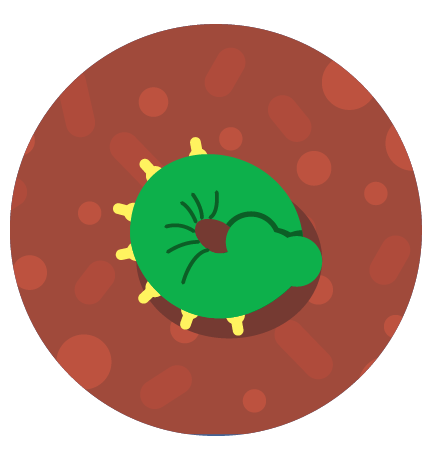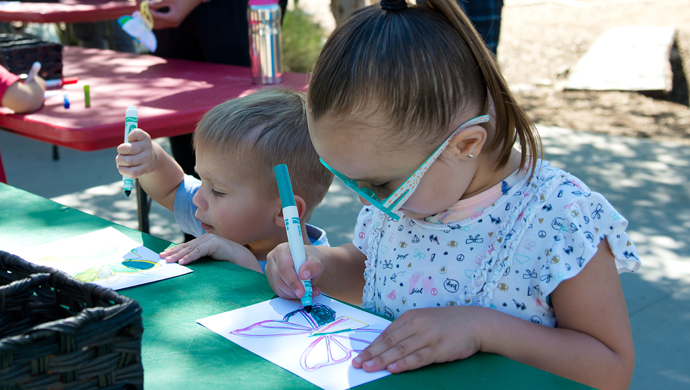
Butterfly Season is here!
Kidspace is celebrating the habitat and life cycle of butterflies and other pollinators with hands-on art and science activities for budding naturalists!
Take a twirl in our giant interactive Los Trompos. Dress up like a butterfly and spread your wings in our fantasy flutter-by. Plus adopt live caterpillars to raise and release painted lady butterflies! There will be so much for your little love bug to explore.
Get Tickets
Raise a live caterpillar
Butterfly Season wouldn't be complete without a caterpillar. The entire family will marvel as science and nature come together in this transformative experience.
Witness the dramatic metamorphosis as you watch them go from hungry, hungry caterpillar to delicate chrysalis and emerge into a Painted Lady butterfly, ready to release into your garden or neighborhood park. Caterpillars and butterfly kits are available at the Kidspace Store during Butterfly Season.
Adopt Your Caterpillars
Wonder

Curiosity

Imagination
Learn More About Butterflies



Caterpillar Care Guide
Kidspace celebrates the life cycle of butterflies and other pollinators. By sharing in their amazing transformation from egg to hungry, hungry caterpillar to delicate chrysalis to beautiful butterfly, we can better appreciate how beautiful and special they are. Butterflies are insects that go through metamorphosis as they grow. This means the animal’s body looks different during each stage of its life.
Butterflies are vital parts of our natural world. They are important plant pollinators, like bees. Because of their sensitivity to shifts in their ecosystems, scientists use them as a metric for change within local environments. This guide will provide information on how to care for your adopted Painted Lady caterpillar and what to look for as it grows and emerges as a butterfly until it is ready to be released into nature.
Egg 
The Painted Lady butterfly egg is a blue color with ridges along the side of the egg. Within a week of transforming into an adult, it will mate and lay eggs on a host plant.
Caterpillar
LARVAL STAGE

In nature, a caterpillar will eat the host plant it hatched on. It enjoys a range of plants, including hollyhock, wild sunflower, mallow, and thistle. If space allows, try to grow some of these in your garden. It is important for us to create and preserve these habitats to support butterfly populations. The brown substance in your caterpillar cup is the food they will need to grow.
CARE
Remember you are caring for a living creature!

Keep the lid on.
The food inside its container will stay clean and soft for the caterpillar to eat.

Keep the container still and upright.
Avoid shaking the container.

Keep out of the direct sunlight.
Caterpillars can get too hot.
WHAT TO WATCH FOR

Silk
In 2-4 days, your Painted Lady caterpillar will weave a tent from its silk for protection.

Playing Dead
If you accidentally shake the cup, your caterpillar may think you are a predator, and curl into a ball to “play dead.”

Frass
As your caterpillar eats and digest its food, it will leave waste, or frass (insect poop) behind.

Hanging in a "J" shape
When your caterpillar is ready to make a chrysalis, it will climb to the top of the container and hang down head first in a “J” shape.
Chrysalis
PUPAL STAGE

As the caterpillar eats, it will need to shed its exoskeleton to make room for its growing body. At the end, it will transform into a chrysalis, which is a process called pupating. Painted Lady butterflies are not a species that builds a cocoon, a layer of silk around their chrysalis, like moths do.
CARE
- 3 days after the chrysalis has formed, you will need to transfer it to a larger habitat. First, place an adhesive like strong tape, glue dots, or Velcro to the top part of the lid. Large cup lids can be gently inserted vertically into the chrysalis log provided with purchase. Slowly remove the lid with the chrysalis attached. Gently brush away any silk or frass from around the chrysalis, so the butterfly will have room to spread its wings. Adhere the lid to the top of the new habitat.
- Include a small branch in your habitat. It will need plenty of room to stretch and dry its wings before release. Purchase a Butterfly Habitat from our Kidspace Store or build your own at home following our instructions at here.
- WHAT TO WATCH FOR Over the next 7 to 10 days, cells inside the chrysalis are rearranging themselves into a new shape, a butterfly!
Butterfly
ADULT STAGE

The butterfly is now winged! As an adult, it will eat nectar from a variety of flowers, find mates, and lay eggs to start the life cycle all over again. Want to learn more about butterfly colors, patterns, and how butterflies see?
CARE
Give your butterfly a fresh orange slice. After your butterfly has pumped its wings up and is ready for fight, it’s going to be hungry! Place a fresh orange slice in your habitat as soon as it emerges. This will act as a temporary substitute for nectar until you release your butterfly in the next 1-2 days.
WHAT TO WATCH FOR
- Your butterfly’s wings will be damp and look wrinkly when it first emerges. It will pump hemolymph (similar to blood) from its abdomen into its wings to give them shape and structure.
- Red splotches on the floor of the habitat are normal to find. This is waste in liquid form (similar to urine) that is produced during the transformation process.
- Your butterfly will eat the juice of the orange slice using its proboscis, a long mouthpart that uncoils to form a “straw.”
How to Release Your Butterfly
Take your Chrysalis Carrier to a park or a yard. Gently, open the netting and watch your butterfly fly away!
TIPS
- Find a place with lots of flowers, so your butterfly can easily find something to eat.
- Avoid touching their wings, it is easy to knock off their scales.
- Avoid releasing the butterfly in the morning when birds are more active.

Congratulations!
Your butterfly is now a vital part of California’s natural environment. Over the next few days, it will pollinate plants transferring pollen grains from flower to flower making it possible for flowers and plants to grow. Now you are ready to explore and be on the look out for more caterpillars and other pollinators like bees and hummingbirds.

More Butterfly Resources
Supported in part by:






